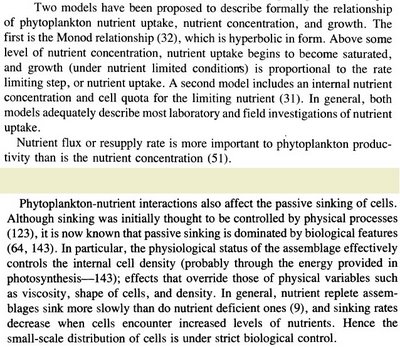Kendra L. Daly, Walker O. Smith, Jr.
Annual Review of Ecology and Systematics, Vol. 24 (1993) pp 555-585
An excellent review article.
Daly and Smith(1993) review biological and physical interactions in oceans to see how they influence plantonik growth (mostly phytoplankton, but zooplanktons are also discussed) . As the paper talks only about marine environment the discussion is difficult to apply to a much smaller estuarine system; the currents in the oceans and the light gradient due to a much much greater depth are not applicable. also the freshwater influence, which will be significant for esturies, is not accounted for.
The similarity however is that they are both fluid and the organisms of interests are the same. Some questions are applicable to both ecological systems. It is also interesting to see how coastal estuarine systems interacts with the larger scale marine environment, from the latter's perspective. the discussion of estuarine systems is too peripheral and too generic to be of much direct use.
The paper is well organised; it is divided into 2 sections-
a) Physical interactions
which talk about physical processes like motion and light etc.
large scale - 1,000 to >10,000 km & years to centuries
mesoscale - 100 m to 100 km & days to months
smallscale - mm to meters & seconds to hours
b) Biological interactions
which talk about interactions between biological entities and between biological entities and their physical environment. these are further classified into large scale; mesoscale and small scale - (i found this classification system fuzzier).
large scale interactions
e.g. large scale heat absorbtion at a global level that impacts global temperature.
mesoscale interactions
at this scale plankton appear to temprarily adapt
??
small scale interactions
phytoplankton - nutrient interactions.
interactions with environment due to physiological response in the cells.
The paper, then, presents two case studies to discuss complexity of interactions. these are marine examples and did not interest me considerably.
interesting quotes from the paper are classified under following headings -
1. Scales of Interaction
2. Aquatic ecosystem
3. Physical indicators and their influence
4. Primary Production



